It’s fun and a bit surprising when you feel a bit of a connection, a camaraderie, with birds you photograph; and lately I’ve been feeling like that happens when you are experiencing the highest level of birding. Really, whether it’s a Golden Eagle or a Piping Plover, it may happen, and it’s a very enriching experience. While photographing on a beautiful white sand beach on an island on the Gulf side of Tampa Bay, I had similar experiences 3 days apart with 2 very similar species of plovers, which included a group of several Piping Plovers and 4 Snowy Plovers.
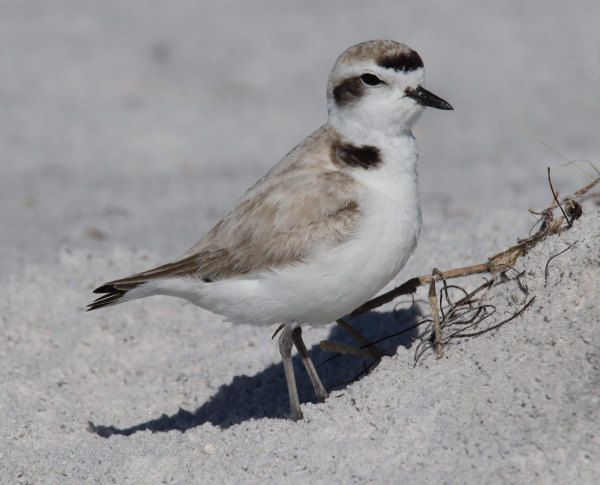
Both plover episodes began similarly, with small sand-colored, previously undetected birds suddenly scurrying across the sand before me. In the first case, a few small sandpipers suddenly began to materialize – Least Sandpipers, Sanderlings, then a couple of Semipalmated Plovers; but where were the “Pipers”? There! Now I could see them, Piping Plovers, cryptically blending with their surroundings; maybe 20 of them, mixed in with Sanderlings, lying down, resting among dried aquatic plants on a little rise of sand near the lagoon’s shore – Hooray! I was quickly immersed in photographing representatives of all these sandpipers and plovers, but as the Piping Plovers eventually began standing up and taking little runs across the sand, I concentrated on the Pipers. Eventually, 4 of the little plovers moved to the water’s edge to forage, which provided a favored setting for photos.
Later, I reflected on the fact that I don’t think I have taken photos of the species in their basic winter plumage before. And I haven’t taken photographs of banded Piping Plovers before either. Only a small percentage of the Piping Plovers had bands, but one in particular had an assortment of leg bands, which I reported to biologists with Florida Audubon. Eventually, I broke away from the nice mix of shorebirds to march down the beach that had become fairly crowded with people, what with the temperature in the low 80s and windless Gulf waters lapping the white sands, it was a perfect beach day to start the new month of February.
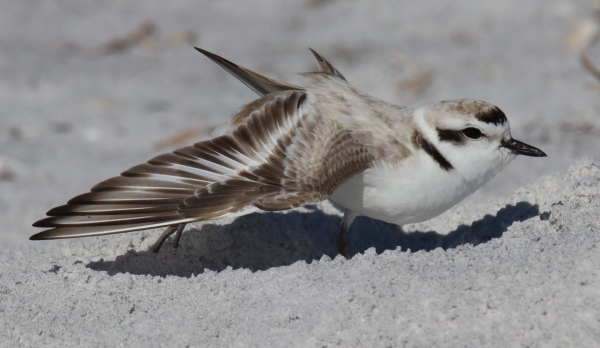
Snowy Beach
The following Saturday morning, just 3 days later, I was compelled to return to the beach to see what birds would be present and lend themselves to my photo interests. Although the sunlight was right, the weather was decidedly different, much cooler and quite windy as a passing front brought rain the previous morning. Even so, I was curious to see what birds I would find, if there was any turnover, any new species – what birds would be present? The simple answer was: None.
Really; none of the shorebirds or wading birds that provided such exciting photo ops 3 days earlier were to be found. The lagoon behind the beach was vacant, aside from an American Kestrel on the hunt along the shore’s edge. After passing areas where oystercatchers, egrets, plovers, and sandpipers were active during my initial visit, I transitioned over to the beach for the mile-long return to my car. I decided not to walk along the waterline, instead hiking where the drier upland sands met the high tide line. Again, nothing; offshore there were a couple Brown Pelicans occasionally diving for a fish, and an Elegant Tern passed overhead occasionally, but that was it until I was close to exiting the beach.
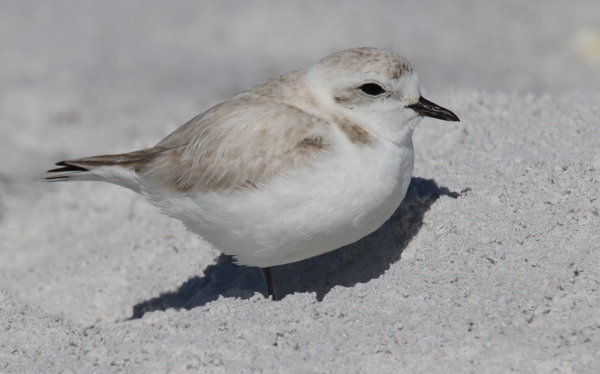
Suddenly, the white sand appeared to be moving until I realized 4 plovers were scurrying immediately in front of my feet. What? Piping Plovers? I quickly realized these were similar-looking Snowy Plovers; what luck! As I moved around the small, mostly white and beige-colored shorebirds to get into photo position without disturbing them more, with the sun at my back and the plovers before me, I began taking the first documentary photos, then photographed each individual with quality images in mind. The little plovers were most accommodating, permitting me to photograph and observe them at fairly close quarters; it seemed they were more concerned about sheltering behind a slight rise in the sand that protected them from the stout wind.
There appeared to be a male that may have been paired with a female, plus a potential second pair in which the male may have been a first-year bird with an equally young female. Among these Snowy Plovers and Wednesday’s Piping Plovers, I truly enjoyed some special moments in their company while creating some especial photos in their midst.
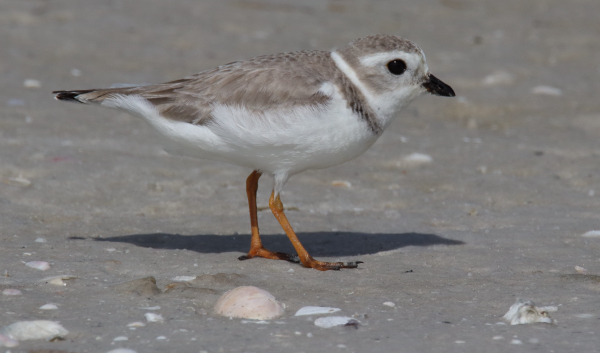
Techy Stuff
During the Snowy Plover photo session Saturday, the mid-morning sunlight provided excellent lighting, and while photographing individual birds I used my usual camera settings, starting with the Av (aperture priority) setting on the Mode Dial of my camera. My aperture (f-stop) was set at f-8 to provide a pretty normal area of focus when zeroed in on the plovers.
With ample available sunlight, the aperture priority (Av) setting created an automatically produced a corresponding shutter speed of 1/4000 of a second, which provided sharp, clear images of the Snowy Plovers.
For the Piping Plovers, I wanted a wider area in focus, so used an f-10 aperture setting, which reduced the shutter speed to 1/2000 or 1/2500 – still plenty fast to stop all the Piper action, which was limited to running at best while I photographed them.
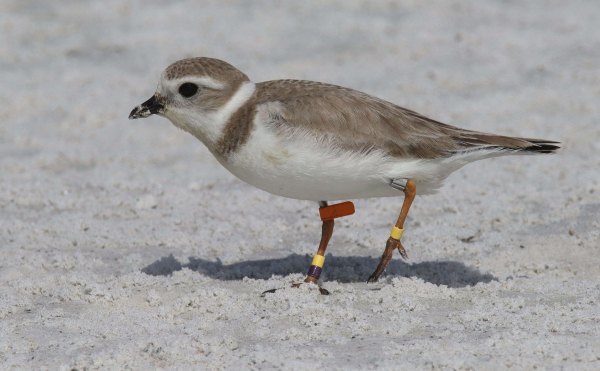
For both plover photo sessions, I used a central spot metering mode, so the light meter was most accurately reading on the bird I was focused on, and that provided excellent color reproduction in spite of the bright sunlight reflecting from the white sand.
With full sunlight available I use a ISO setting of 400 as my standard. Under the bright conditions on the beach, I could have used an ISO 200 or even ISO 100 and still would have had plenty of shutter speed and broad aperture options for the photos; but I tend to try to change the ISO level as little as possible so I don’t forget to reset it when lighting conditions change.
Similar as they are, Piping Plovers and Snowy Plovers are certainly cute little guys, and it was fun to photograph individuals of both species. With resident and wintering birds abundant across the varied landscapes of Tampa, they have provided a new vigor for my birding interests, including photographing a variety of the species I encounter daily. I hope you find renewed inspiration to give your camera and lens a workout during the Presidents Day weekend, and don’t hesitate to send some favorite images to the Great Backyard Bird Count, taking place during this extended weekend from Friday through Monday.
Article and photographs by Paul Konrad
Share your bird photos and birding experiences at editorstbw2@gmail.com